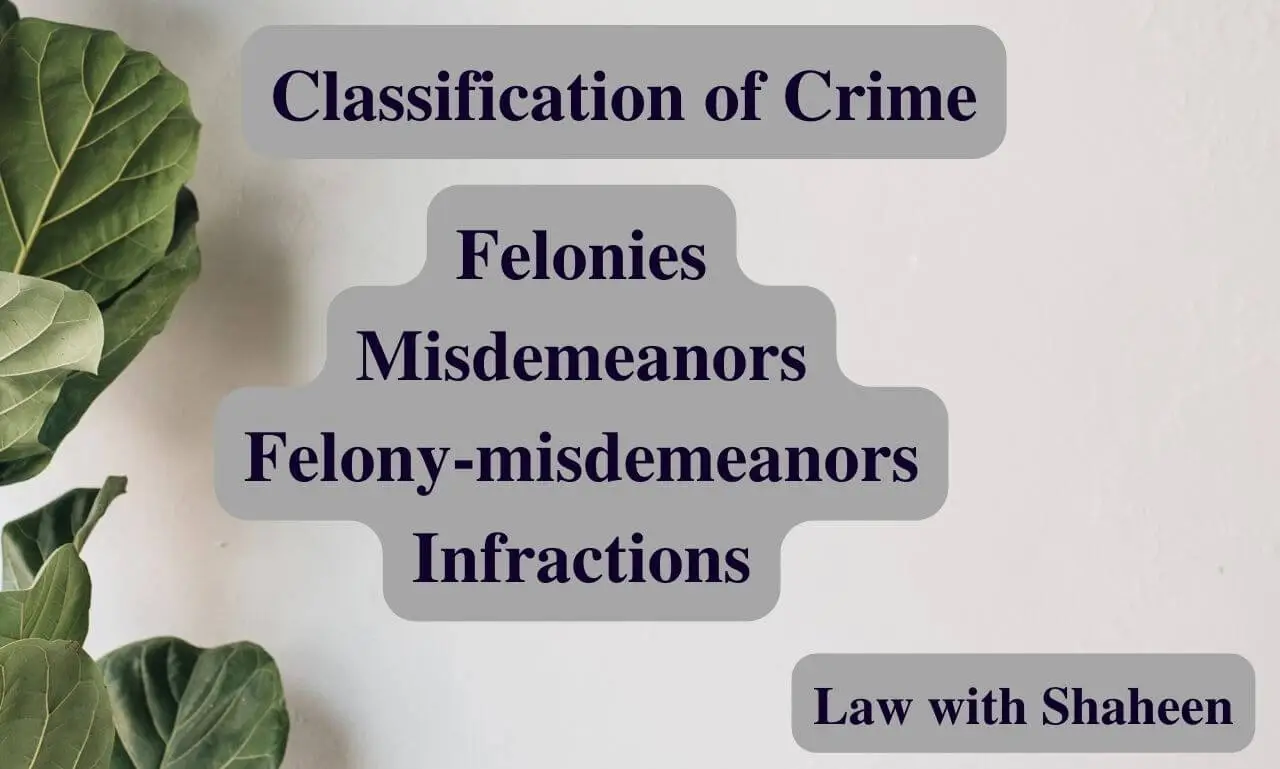Crime is an act committed or omitted in violation of public law forbidding or commanding it. In Pakistan where the whole criminal law is codified, crime means an act punishable by the Pakistan Penal Code or other penal statutes. Here we will discuss in detail the classification of crimes in criminal law:
- Felonies
- Misdemeanors
- Felony-Misdemeanors
- Infractions
Table of Contents
Meaning of Crime:
In legal terms, crime means “every offence punishable by law”.
Definition of Crime:
According to Black’s Law Dictionary:
“A positive or negative act in violation of penal law”.
According to Blackstone:
“An act committed or omitted in violation of a public law forbidding or commanding it”.
According to Islamic Law:
“In Islamic law, crimes are generally associated with sin. Thus crimes have to be morally wrong. Further, this morality is not based upon what the public may consider being right or wrong, that is, moral or immoral, rather it is the lawgiver who determines the morality or immorality of an act”
Essentials of Crime:
1). Human Being:
The first essential of a crime is that the act must be committed by a human being who;
i. Must be under a legal obligation to act in a particular manner, and
ii. Should be a fit subject for award of appropriate punishment.
2). Mens Rea:
The second important essential of a crime is Mens rea or evil intent. There can be no crime of any nature without an evil mind. Every crime requires a mental element; even in strict or absolute liability, some mental element is required. That is why Mens rea is considered a fundamental principle of penal liability.
3). Actus Rea:
Some overt act or illegal omission is necessary to take place in pursuance of the guilty intention. It is said that something in addition to a Mens Rea is required to produce criminal harm, and the Actus Rea is constituted by the event and not by the activity which caused the event.
4). Injury:
It is essential that the injury should be illegally caused to any person i.e., a human being in body, mind, reputation, or property.
Classification of Crimes:
Classification of crime by severity of punishment is more important than the title belonging to the crime’s classification. Crimes are grouped into four categories: felonies, misdemeanors, felony-misdemeanors, and infractions. Plenty of time is generally spent on defining criminal intent.
1). Felonies:
Felonies are the most serious crimes. They are either supported by a heinous intent, like the intent to kill, or accompanied by an extremely serious result, such as loss of life, grievous injury, or destruction of property.
Felonies are serious, so they are graded the highest, and all sentencing options are available. Depending on the jurisdiction and the crime, felonies include sentences like execution, prison time, a fine, or alternative sentencing such as probation, rehabilitation, and home confinement.
Potential consequences of felony crimes also include the inability to vote, own a weapon, or even participate in certain careers.
2). Misdemeanors:
Misdemeanors are less serious than felonies, either because the intent requirement is of a lower level or because the result is less extreme. These are usually punishable by jail time of one year or less per misdemeanor, a fine, or alternative sentencing like probation, rehabilitation, or community service.
Note that incarceration for a misdemeanor is in jail rather than prison. The difference between jail and prison is that cities and counties operate jails, and the state or federal government operates prisons, depending on the crime. The restrictive nature of the confinement also differs between jail and prison.
Jails are for defendants who have committed less serious offences, so they are generally less restrictive than prisons.
3). Felony or Misdemeanor:
Felonies and misdemeanors are crimes that the government can prosecute and punish as either a felony or a misdemeanor, depending on the particular circumstances accompanying the offence.
The discretion of whether to prosecute the crime as a felony or misdemeanor usually belongs to the judge, but in some instances, the prosecutor can make the decision.
4). Infractions:
Infractions are the least serious crimes and include minor offences such as jaywalking and motor vehicle offences that result in a simple traffic ticket. It can also be called a violation.
These are generally punishable by fines or alternative sentencing such as traffic school.
In conclusion, crime can be classified by the severity of punishment. The most severe crimes are punishable by death or life imprisonment, while the least severe crimes are punishable by a fine or a short prison sentence. The severity of punishment should reflect the severity of the crime, and the punishment should be proportionate to the harm caused.
Frequently Asked Questions (FAQs)
Money laundering is a type of white-collar crime that involves disguising the origins of money that has been obtained illegally. This can be done by transferring the money through a series of bank accounts or by purchasing assets with the money. Money laundering is a criminal offence in most countries.
Homicide is the leading cause of death for young black males in the United States. It accounts for more than half of all deaths in this population group.
Crimes are classified into two categories: felonies and misdemeanors. Felonies are more serious crimes, punishable by more than a year in prison. Misdemeanors are less serious crimes, punishable by less than a year in prison. Crimes that fall in between felonies and misdemeanors are called gross misdemeanors and are punishable by up to 364 days in prison.
